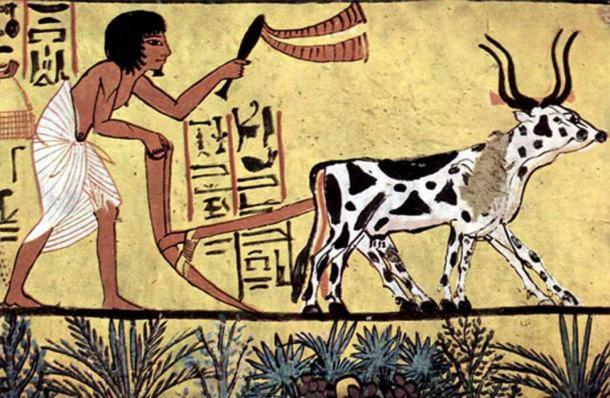The Nile River spans almost 4,175 miles (6,719 km), crosses nine countries throughout Africa, and is widely regarded as the longest river in the world. While all this might be considered common knowledge, the winding waters of the famous river have many intriguing facts that you might not know. Here are ten of the most fascinating facts about the Nile River.

Blue Nile Falls, Ethiopia, Africa. ( alekosa /Adobe Stock)
1. Without the Nile, the Ancient Egyptian Civilization May Never Have Existed
The Nile River was considered the source of life by the ancient Egyptians and played a vital role in the country’s history and rich culture. The river was also a very important factor in the socioeconomic development and success of ancient Egypt. Without the Nile River, the great ancient civilization may have never existed since rainfall was almost non-existent in Egypt and the Nile River was the only source of moisture to sustain crops.

Burial chamber of Sennedjem, Scene: Plowing farmer. ( Public Domain )
2. The Real Source of the Nile River Remains Unknown
Some might tell you that Lake Victoria , Africa’s main lake, is the source of the Nile River. Others will say the Kagera River and its tributary the Ruvubu, having its headwaters in Burundi, is the real source. The truth is, however, that the source of the Nile River remains a mystery to this day.

The Nile river in Uganda. (Rod Waddington/ CC BY SA 2.0 )
3. The Nile “Highway”
The Nile River was the “highway” that joined the country together and was essential for trade and transportation. Up until the 19th century, travel by land was virtually unknown in the region. Ships and boats were the main means of transporting people and goods around the country.

An ancient Egyptian boat. ( Public Domain )
4. Nile, The Life-Giver
Other than providing water, the Nile offered an excellent soil for growing food , which is the main reason why so many Egyptians lived near it. Locals used spears and nets to catch fish and trap different birds that flew close to the surface of the water.

4th Dynasty of Egypt painting: Trapping (harvesting) birds; Plowing fields. ( Public Domain )
5. Contributing to the Production of Papyrus
So much of what we know about ancient Egypt comes from the plethora of written records left behind on papyrus. The Nile was responsible for providing this papyrus. It came from the reeds growing on the side of the river.

Egyptian peasants harvesting papyrus, mural painting in Deir el-Medina (early Ramesside Period). ( Public Domain )
6. The Flooding of the Nile
Melting snow and heavy summer rain within the Ethiopian Mountains sent a torrent of water, causing the banks on the River Nile in Egypt to overflow in this flat desert land, causing massive floods every year. The reason why it does not flood now is because of the construction of the Aswan High Dam in the 1960s.

A view of Aswan High Dam. (Frostie 2006/ CC BY SA 2.0 )
7. Akhet: The Inundation
Until the Aswan High Dam was built, the yearly inundation of the Nile happened between June and September, in a season the Egyptians called akhet: the inundation. This was seen by the Egyptians as a yearly coming of the deity Hapi, bringing fertility to the land. The goddess of the flood was the goddess Mehet-Weret, “The Great Flood.”

Hapi, shown as an iconographic pair of genii symbolically tying together upper and lower Egypt. ( CC BY SA 3.0 )
8. Osiris: The Nile’s Most Sacred God
Despite Hapi being the local deity in a way, the god most closely associated historically and culturally with the Nile was Osiris, who was killed by his brother Seth on the riverbank and then became the king of the Underworld. For that reason, the Nile River was an important part of Egyptian spiritual life as well. The Egyptians believed that it was the passageway between life and death. That’s why all Egyptian tombs are built on the west side of the Nile – the west was considered the place of death since the sun god Ra set in the west each day.

Osiris with an Atef-crown made of bronze in the Naturhistorisches Museum (Vienna). ( CC BY SA 3.0 )
9. A Popular Ancient Sport was Played on the Nile’s Waters
Ancient Egyptians practiced a popular river sport – water jousting. Modern knowledge of this sport comes from studying ancient Egyptian tomb reliefs thus it is limited. These depictions show that vessels held a small group of men, each one wielding a long pole. While most of the crew used theirs to maneuver the boat, a few of them would stand upright, wielding their poles to knock opponents off their respective boats.

Two depictions of ancient Egyptian water jousting. ( Public Domain ) and ( PennState University )
10. The Nile’s Oldest “Residents”
Crocodiles have been living in the Nile Rivers’ waters for thousands of years and they don’t really like it when humans get close to them. They are known to attack humans regularly, usually people washing clothes or fishing at the shore. It’s estimated that there are 200 attacks a year from Nile crocodiles in Africa.
Top Image: Digital reconstruction of the Nile River from Assassin’s Creed Origins. Credit: Ubisoft
Updated on December 1, 2020.
Cruise on the Nile in style with Ancient Origins Tours in 2021. For more information on the Ancient Origins Egypt Tour click here .
Related posts:
Views: 0
 RSS Feed
RSS Feed

















 December 2nd, 2020
December 2nd, 2020  Awake Goy
Awake Goy 
 Posted in
Posted in  Tags:
Tags: 
















